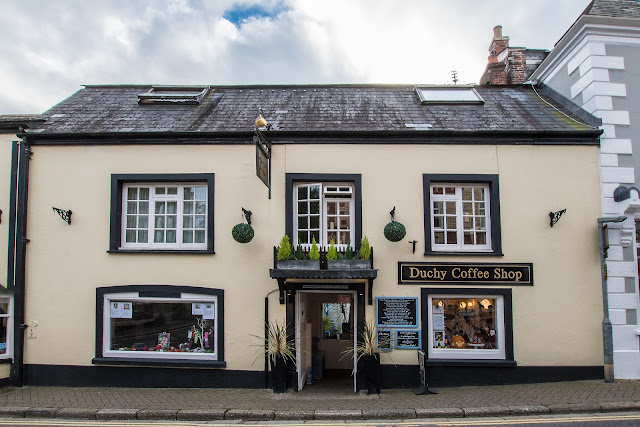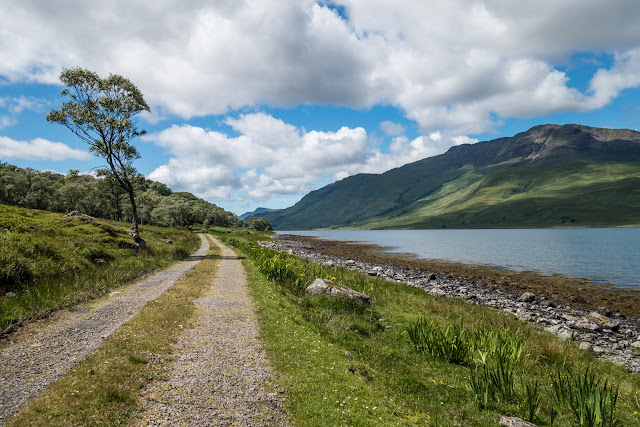Lostwithiel, Fowey then onto Golitha Falls
Thursday started as an easy morning looking, and finding, a local Geocache with Izobelle and Rosey. Afterwards we went for coffee and cake to the Duchy Coffee shop near by. It had looked very tempting from the outside and we were not disappointed.

Coffee and cake digested, on the way back I took a picture of St Bartholomew Church near the house. The present church at Lostwithiel was mainly built around 1300, though first mentioned in about 1220. Before this, Lostwithiel inhabitants had to climb the steep hill to Lanlivery or go down river to St Winnow to worship.
Built in the Early English (or first Gothic) style when the town was a prosperous river port, Lostwithiel church stood at the top of a medieval triangular marketplace. The Duchy Palace and river crossing were at the lower end of this space.
Most Cornish churches were enlarged in the late medieval and Tudor period when the tin industry started to generate wealth, but not Lostwithiel. A new churchyard cross of lantern type was commissioned for the churchyard, but the church was left alone. As a result, the church still has clerestories (upper windows) and narrow lean-to aisles as per the original plan. Sepulchral recesses, possibly designed for the Cardinhams who were lords of the borough of Lostwithiel before the Earls and Dukes of Cornwall, remain on the outside of the building. Inside, the church pillars are octagonal and lack capitals, as at Fowey and some French churches, and there is no chancel arch. The crowning glory however is the early 14th. century spire, now reduced in height, with a Catherine Wheel on the side facing the bridge.
Methodist Free Church with attached Sunday School, dated 1900. Lostwithiel United Free Methodist Church was constructed on The Bank (renamed Albert Terrace in 1846 after the visit of Queen Victoria and Albert). This chapel was rebuilt in the late 1890’s and was reopened in 1900 becoming known locally as Bank Methodist Chapel. The chapel was closed in 1987 and converted into apartments and the local Methodists then met in nearby St Saviours Church (Anglican) on Grenville Road.
And then we headed to Fowey again.
A great sky above the houses on the riverside of Fowey facing the water. What a view!
Some of the narrow streets of Fowey
I wondered where it came to rest!
The King of Prussia Pub on the QuaySide, Fowey, named after an infamous local. John Carter of Prussia Cove was known as the “King of Prussia” and was the most successful and notorious smuggler of the Penzance district between 1777 and 1807, together with his two brothers, Harry, and Charles. According to 19th century historian Sabine Baring-Gould, John Carter received his nickname as a boy. The cove was originally called Porthleah but became Prussia Cove in recollection of Carter’s exploits.
This tanker was entering the estuary as we wandered along. Not sure of its cargo. Finished with a coffee and cake before heading home to take a few more photos in the vicinity of our house and then to Monopoly - and Izobelle won!
Friday was a day we went in different directions and unfortunately the weather was cold, windy and prone to showers. Rosey and I wanted to go toward Bodmin, initially to Golitha Falls and then onto an area near Minnion.
The Golitha Falls are a series of spectacular cascades and waterfalls along a section of the river Fowey as it makes its way through the ancient oak woodland of Draynes Wood. It is one of the best known beauty spots on Bodmin Moor.
As the river flows through the woods the scenery varies, from wide wooded glades to the steep sided, craggy gorge where the falls are at their most dramatic. Over the course of the falls the river descends 90 metres meaning the water is always fast flowing
It wasn't too difficult to find and, well wrapped up, we set off from the car park.
It was beautiful to walk along beside the River Fowey, albeit it became more difficult underfoot, until we came to a point where we were warned about the difficult path ahead. Time to stop and head back!
Beheaded and left behind!
Having finished our walk, we headed to Minion and looked for somewhere to go for lunch. We found a pub claiming to be the highest on Bodmin and it took its name from our next proposed stop - The Cheesewring.
We had a great meal and pointed ourselves for a trek across the moor toward The Cheesewring, which is a giant formation of rocks that we had not seen before. However, we were walking toward our starting point but turned back because of the darkening sky and howling chilly wind.
We decided - not today! So what to do?
Then we remembered Restormel Castle on the outskirts of Lostwithiel, and decided that it was a better bet.
A massive circular shell keep built atop an early Norman motte and bailey castle, one of the most complete remaining examples in the West Country. The domestic buildings within the circular curtain walls are largely intact, as is the high wall. There was an outer bailey enclosing the site, but most traces of that are gone, leaving only the striking ruin of the stone walled shell keep atop concentric earthworks, surrounded by a dry ditch and banks.
Sometime around 1100 the Norman Sheriff of Cornwall, Baldwin Fitz Turstin, erected a fortification on a spur of land above the river Fowey.
We know very little about the earliest castle, which was built of wood, and the first time that Restormel enters the written historical record is in 1264, when the leader of the Baron's War, Simon de Montfort, seized the castle. Though the initial fortifications were made of wood, the square stone gatehouse tower (now largely ruinous) was soon added.
The circular stone curtain which is Restormel's most unique feature was probably built by Robert de Cardinham, who was lord of the manor here from 1192-1225. Robert's curtain wall enclosed an area roughly 40 metres across, within the earlier earthworks. The curtain wall is over 2.5 metres thick (about 8 feet) and stands to the height of an inner wall walk protected by a parapet.
Around 1270 Restormel passed into the hands of the powerful Earls of Cornwall. When Earl Edmund chose to make the administrative centre of his estates at nearby Lostwithiel, Restormel became his major residence. It was Earl Edmund who added the curious set of curving chambers backing onto the curtain wall, effectively creating a concentric castle with kitchens, hall, guest accommodation, and private solar inside the castle walls.
When Earl Edmund died in 1299 the Earldom of Cornwall reverted to the crown, and Restormel lost its importance. After the Duchy of Cornwall was formed the castle was ignored and left to decay, save for a brief period in 1354 when Edward, The Black Prince, son of Edward III, held court here as the first Duke of Cornwall. But when Edward died in 1376 the castle was left unused again.
There was a moment on the historical stage for Restormel in 1644 when Royalist forces under Sir Richard Grenville briefly occupied it, ousting a Parliamentarian garrison, but after this brief interlude it was left to slumber once more, falling into complete disrepair until taken into state care in 1925. It is now officially owned by the Duchy of Cornwall but cared for by English Heritage.
So, it was back to Lostwithiel and to contemplate getting ready for our journey home tomorrow. It's been a great holiday with the family and hope we can repeat it.




















Comments